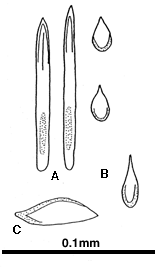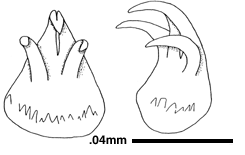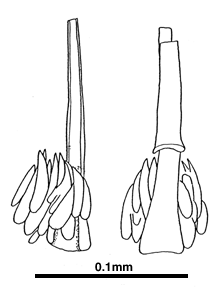A
small Dondersiidae to 3.2 mm long with a rough but glistening spicular
coat. Like Dondersia and Ichthyomenia greatest height near
anterior end, to 0.5 mm, but tapering rapidly to an anterior point; height
near posterior end to 0.4 mm, tapered to a fingerlike projection above
a bulbous ventral lobe containing the copulatory spicule sac (lacking in
immature specimens), mantle cavity a shallow depression beneath the fingerlike
projection; body narrowest somewhat anterior to posterior end, to 0.3 mm
in height. Cuticle and epidermis 5 µm and 7 to 8 µm thick,
respectively. Contracted mouth opening bilobed; contracted pedal pit indistinct;
pedal groove ending on ventroposterior lobe. Dorsoterminal sense organ
not distinguished.
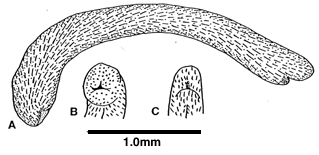

Epidermal
spicules of two types : first type elongate, slender, to 100 µm long
by 9 µm wide and up to 5 µm thick, but most only 2 to 3 µm
thick, width same throughout, thickest proximally, with slight distal trough
sometimes with a distal ridge; second type ovate with distal end drawn
out into a point, rimmed proximally, 2 µm or less in thickness, to
20 µm long by 13 µm wide on midbody and to 34 µm long
at posterior end; spicules from beside pedal groove rimmed, to 52 µm
long by 20 µm wide and 4 µm thick at rim.
Radula
(4 examined) with 8 rows of monostichous teeth 50 µm in height by
40 µm wide, base with a faint line of bumps or serrations pointed
distally; denticles deeply curved (Figs 3C, D).
Copulatory
spicules not paired, formed of two elongate pieces, one about 150 µm
long, flared and troughlike proximally, accompanied ventrally by clustered,
small accessory spicules about 40 µm long; the other copulatory spicule
with a proximal collar, about 80 µm long, partly wrapped around the
longer, flared piece.
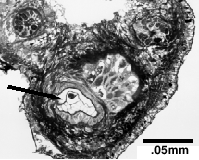
The
reproductive system has not been unambiguously described for Lyratoherpia.
In L. incali the gonopericardial ducts are paired (B). Paired seminal
vesicles open posteriorly from the pericardium (C) and empty into the upper
gametoducts (F), which descend vertically to join the narrow, paired lower
gametoducts far posteriorly. Paired saclike seminal receptacles lie anterior
to and above the lower gametoducts and are distally bifurcate (E); they
enter the anterior ends of the lower gametoducts through stalks (D). Beneath
the lower gametoducts is a single voluminous copulatory spicule sac, anteriorly
glandular and surrounded by a thick layer of circular muscles (F). This
gland may have been mistaken for the fused portion of the lower gametoducts
in L. carinata, in which copulatory spicules were not detected (Salvini-Plawen,
1978). The copulatory spicule sac narrows posteriorly to form the portion
containing the unpaired group of copulatory spicules (G), their former
presence before dissolution marked by matrices in histologic sections (above,
arrow). The sac opens dorsally into the shallow depression serving as a
mantle cavity. The lower gametoducts remain narrow and paired until their
union shortly before emptying ventrally into the shallow mantle cavity
depression and anterior to the opening of the rectum (H).
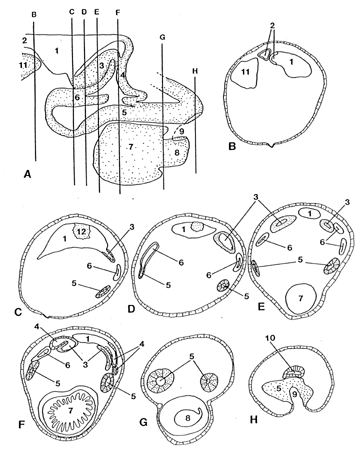
A,
reconstruction from histologic sections, anterior to left. B-H, semischematic
cross-sections, somewhat skewed, midgut and rectum not shown except in
H (see text for description). 1 pericardial cavity, 2 gonopericardial duct,
3 seminal vesicle, 4 upper gametoduct, 5 lower gametoduct, 6 seminal receptacle,
7 glandular portion of copulatory spicule sac, blind end indicated in E,
8 spicule-containing portion of copulatory spicule sac (see histologic
section above), 9 mantle cavity, 10 rectum, 11 gonad. (A, modified from
Scheltema et al., 1994.)
From Ophelia 51 (1): 1-28 (1999).
Lyratoherpia sp., Scheltema et al. 1994, figs. 3b,d, 5g, 23a,
24b,h
Type locality. -- West European Basin, 57°59.7'N, 10°39.8'W,
2,091 m (INCAL [CENTOB] DS-01, 15.vii.1976).
Holotype. -- MNHN (alcohol specimen, spicule slide). Total length 3.2
mm, height 0.4 mm at anterior end, 0.3 mm at posterior end, and 0.2 mm
at narrowest. Paratype 1. -- MNHN (dissected alcohol specimen, radula slide,
spicule slide including copulatory spicules). Total length 3.1 mm, heights
0.5 at anterior end, 0.4 at posterior end, and 0.3 at narrowest; type locality.
Etymology. -- lyra = a lyre, or harp; -herpia = a creeping
thing; incali , named for Centre National de Tri d'Océanographie
Biologique cruise INCAL.



